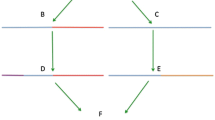Summary
Use of chromosomal markers can accelerate genetic progress for quantitative traits in pedigree selection programs by providing early information on Mendelian segregation effects for individual progeny. Potential effectiveness of selection using markers is determined by the amount of additive genetic variance traced from parents to progeny by the markers. Theoretical equations for the amount of additive genetic variance associated with a marker were derived at the individual level and for a segregating population in joint linkage equilibrium. Factors considered were the number of quantitative trait loci linked to the marker, their individual effects, and recombination rates with the marker. Subsequently, the expected amount of genetic variance associated with a marker in a segregating population was derived. In pedigree selection programs in segregating populations, a considerable fraction of the genetic variance on a chromosome is expected to be associated with a marker located on that chromosome. For an average chromosome in the bovine, this fraction is approximately 40% of the Mendelian segregation variance contributed by the chromosome. The effects of interference and position of the marker on this expectation are relative small. Length of the chromosome has a large effect on the expected variance. Effectiveness of MAS is, however, greatly reduced by lack of polymorphism at the marker and inaccuracy of estimation of chromosome substitution effects. The size of the expected amount of genetic variance associated with a chromosomal marker indicates that, even when the marker is not the active locus, large chromosome substitution effects are not uncommon in segregating populations.
Similar content being viewed by others
References
Botstein D, White RL, Skolnick M, Davis RW (1980) Construction of a genetic linkage map in man using restriction fragment length polymorphisms. Am J Hum Genet 32:314–331
Bulmer MG (1971) The effect of selection on natural variability. Am Nat 105:201–211
Chakravarti A, Elbein SC, Permutt MA (1986) Evidence for increased recombination near the human insulin gene: implication for disease association studies. Proc Natl Acad Sci USA 83:1045–1049
Cowan CM, Dentine MR, Ax RL, Schuler LA (1990) Structural variation around prolactin gene linked to quantitative traits in an elite Holstein sire family. Theor Appl Genet 79:577–582
Dentine MR, Cowan CM (1990) An analytical model for the estimation of chromosome substitution effects in the offspring of individuals heterozygous at a segregating marker locus. Theor Appl Genet 79:775–780
Falconer DS (1981) Introduction to quantitative genetics, 2nd edn. Longman, London
Fernando RL, Wang TW (1989) Marker-assisted selection using best linear unbiased prediction. J Dairy Sci 72 [Suppl. 1]:31
Fries R, Ruddle FH (1986) Gene mapping in domestic animals. In: John JS (ed) 10th Beltsville Symp Agric Res: Biotechnology for solving agricultural problems, vol 10, pp 19–37
Geldermann H (1975) Investigations on inheritance of quantitative characters in animals by gene markers. 1. Methods. Theor Appl Genet 46:319–330
Haldane JBS (1919) The combination of linkage values and the calculation of distances between the loci of linked factors. J Genet 8:299–309
Jeffreys AJ, Wilson V, Thein SL (1985) Individual-specific “fingerprints” of human DNA. Nature 316:76–79
Kempthorne O (1955) The theoretical values of correlations between relatives in random mating populations. Genetics 40:153–167
Lande R, Thompson R (1990) Efficiency of marker-assisted selection in the improvement of quantitative traits. Genetics 124:743–756
Lander ES, Botstein D (1989) Mapping Mendelian factors underlying quantitative traits using RFLP linkage maps. Genetics 121:185–199
Lin CC, Newton DR, Church RB (1977) Identification and nomenclature for G-banded bovine chromosomes. Can J Genet Cytol 19:271–282
Paterson AH, Lander ES, Hewitt JD, Peterson S, Lincoln SE, Tanksley SD (1988) Resolution of quantitative traits into Mendelian factors by using a complete linkage map of restriction fragment length polymorphisms. Nature 335:721–726
Smith C, Simpson SP (1986) The use of genetic polymorphisms in livestock improvement. J Anim Breed Genet 103:205–217
Soller M (1978) The use of loci associated with quantitative effects in dairy cattle improvement. Anim Prod 27:133–139
Soller M, Beckmann JS (1982) Restriction fragment length polymorphisms and genetic improvement. In: Proc 2nd World Congr Genet Appl Livestock, Madrid, pp 396–404
Soller M, Brody T, Genizi A (1982) The expected distribution of marker-linked quantitative effects in crosses between inbred lines. Heredity 43:179–190
Stam P (1986) The use of marker loci in selection for quantitative characters. In: Smith C, King JWB, McKay JC (eds) Exploiting new technologies in animal breeding genetic developments. Oxford University Press, Oxford, pp 170–182
Turner HN, Young SY (1969) Quantitative genetics in sheep breeding. Macmillan, Melbourne
Weller JI, Kashi Y, Soller M (1988) Estimation of the sample size necessary for genetic mapping of quantitative traits in dairy cattle using genetic markers. J Dairy Sci 71 [Suppl. 1]:142
Author information
Authors and Affiliations
Additional information
Communicated by D. Van Vleck
Rights and permissions
About this article
Cite this article
Dekkers, J.C.M., Dentine, M.R. Quantitative genetic variance associated with chromosomal markers in segregating populations. Theoret. Appl. Genetics 81, 212–220 (1991). https://doi.org/10.1007/BF00215725
Received:
Accepted:
Issue Date:
DOI: https://doi.org/10.1007/BF00215725



